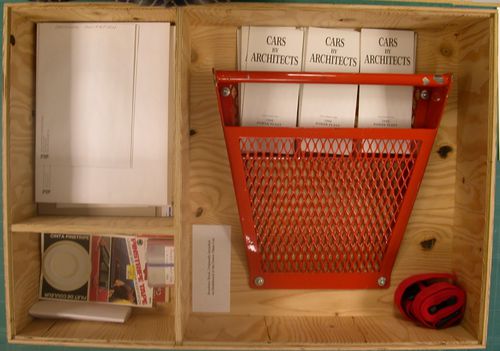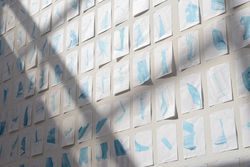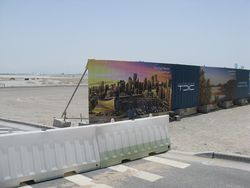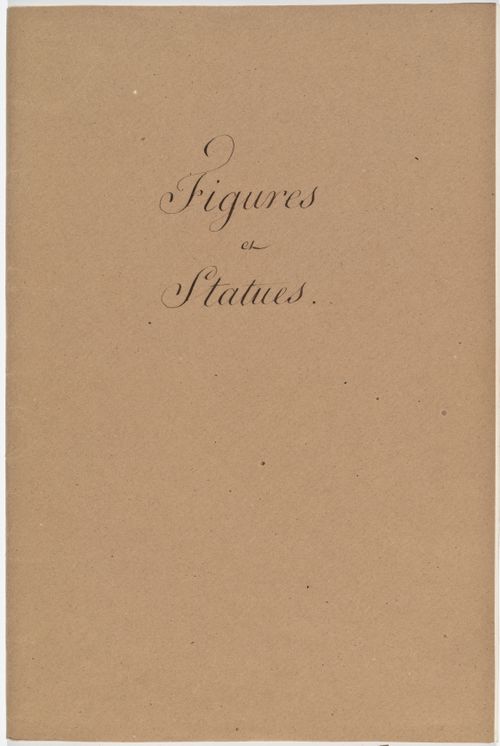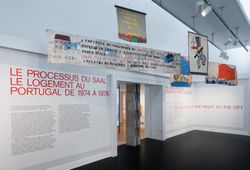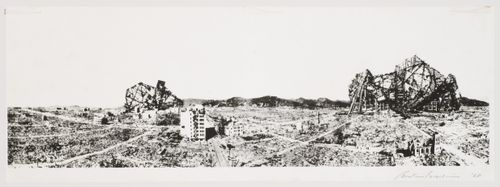DR2007:0020
Description:
This consists of a boxed set of related pieces from L.W. Richards participation in "The Architecture Series" at the Power Plant contemporary art gallery in 1988-89. L.W. Richards renovated and drove a Pontiac Firebird, named "Power Plant". The project was the subject of Vikky Alexander's essay "Back to the Future" in the Power Plant Gallery's "The Architecture Series", 1989, pp.25-31. The project was reviewed by Adele Freedman (Globe and Mail, March 5, 1988, p.C12), Christopher Hume (Architect designs gallery on wheels, Toronto Star, Feb. 27, 1988, p. G15), and pictured and discussed in The Canadian Architect, Vol. 33, no. 4, April 1988, p.6. The set pf pieces includes: a) B&W photograph of the Power Plant car in an auto-body workshop, b) The Architecture Series, booklet with Alexander's essay, c)newspaper and magazine clippings/reviews, d)orangesteel brochure rack, that L.W. Richards designed, from the Power Plant car (~ 18" x 18" x 3"), e) nine B&W brochures titled "Cars by Architects" that fit into the red-orange rack, and f) ~ 20 colour slides of the Power Plant car in various locations in Toronto.
1988-1989
Power Plant (Cars by Architects), 1988-1989
Actions:
DR2007:0020
Description:
This consists of a boxed set of related pieces from L.W. Richards participation in "The Architecture Series" at the Power Plant contemporary art gallery in 1988-89. L.W. Richards renovated and drove a Pontiac Firebird, named "Power Plant". The project was the subject of Vikky Alexander's essay "Back to the Future" in the Power Plant Gallery's "The Architecture Series", 1989, pp.25-31. The project was reviewed by Adele Freedman (Globe and Mail, March 5, 1988, p.C12), Christopher Hume (Architect designs gallery on wheels, Toronto Star, Feb. 27, 1988, p. G15), and pictured and discussed in The Canadian Architect, Vol. 33, no. 4, April 1988, p.6. The set pf pieces includes: a) B&W photograph of the Power Plant car in an auto-body workshop, b) The Architecture Series, booklet with Alexander's essay, c)newspaper and magazine clippings/reviews, d)orangesteel brochure rack, that L.W. Richards designed, from the Power Plant car (~ 18" x 18" x 3"), e) nine B&W brochures titled "Cars by Architects" that fit into the red-orange rack, and f) ~ 20 colour slides of the Power Plant car in various locations in Toronto.
archives
Level of archival description:
Fonds
AP168
Synopsis:
The Neil Denari Interrupted Projections project records, 1994-2004 (predominant 1994-1996), document the development and installation of Denari’s show “Interrupted Projections” at Gallery MA in Tokyo, Japan. The archive consists of original born-digital files and a small amount of physical material, including drawings, transparencies, slides, and promotional materials.
1994-2004
Neil Denari Interrupted Projections project records
Actions:
AP168
Synopsis:
The Neil Denari Interrupted Projections project records, 1994-2004 (predominant 1994-1996), document the development and installation of Denari’s show “Interrupted Projections” at Gallery MA in Tokyo, Japan. The archive consists of original born-digital files and a small amount of physical material, including drawings, transparencies, slides, and promotional materials.
archives
Level of archival description:
Fonds
1994-2004
Project
AP056.S1.1988.PR09
Description:
This project series documents renovations and additions to the Art Gallery of Ontario in Toronto from 1988-1993. The office identified the project number as 18703. This project, known as Phase 3, built upon two other major expansion projects to the art gallery, Phase I and Phase II, that were completed by the architecture firm Parkin Architects Planners in the 1970s. Phase 3 was the winning entry for a limited competition won by KPMB, with Thomas Payne as partner-in-charge, in joint venture with the firm of Barton Myers Inc. This project consisted of 100,000 square feet of additions to the building including a prints and drawings study centre, a reference library and administrative offices in the southwest corner and new vaulted galleries, a tower and pyramidal arrival hall along Dundas Street. The Dundas Street elevation was transformed by these additions and brick facades were added. A new double height sculpture atrium, connected to the Victorian Grange mansion, was also added. This project also included 190,000 square feet of renovations to the existing building including changes to galleries, circulation, vaults, staff areas, the restaurant, bookstore and volunteer shop. The goal of these changes was to create a more coherent design between old and new parts of the building and to reinforce the role of art galleries in contemporary life by increasing the scale of the building and creating new spaces for interaction and participation. This project won the Canadian Architect Award of Excellence in 1988. The project is recorded through drawings, photographic materials and accompanying notes dating from 1986-1992. The drawings include site plans and surveys, sketches, plans, elevations, sections, perspectives, details, studies, axonometric drawings, furnishing and structural drawings and some presentation drawings.
1986-1992
Art Gallery of Ontario, Phase 3, Toronto (1988-1993)
Actions:
AP056.S1.1988.PR09
Description:
This project series documents renovations and additions to the Art Gallery of Ontario in Toronto from 1988-1993. The office identified the project number as 18703. This project, known as Phase 3, built upon two other major expansion projects to the art gallery, Phase I and Phase II, that were completed by the architecture firm Parkin Architects Planners in the 1970s. Phase 3 was the winning entry for a limited competition won by KPMB, with Thomas Payne as partner-in-charge, in joint venture with the firm of Barton Myers Inc. This project consisted of 100,000 square feet of additions to the building including a prints and drawings study centre, a reference library and administrative offices in the southwest corner and new vaulted galleries, a tower and pyramidal arrival hall along Dundas Street. The Dundas Street elevation was transformed by these additions and brick facades were added. A new double height sculpture atrium, connected to the Victorian Grange mansion, was also added. This project also included 190,000 square feet of renovations to the existing building including changes to galleries, circulation, vaults, staff areas, the restaurant, bookstore and volunteer shop. The goal of these changes was to create a more coherent design between old and new parts of the building and to reinforce the role of art galleries in contemporary life by increasing the scale of the building and creating new spaces for interaction and participation. This project won the Canadian Architect Award of Excellence in 1988. The project is recorded through drawings, photographic materials and accompanying notes dating from 1986-1992. The drawings include site plans and surveys, sketches, plans, elevations, sections, perspectives, details, studies, axonometric drawings, furnishing and structural drawings and some presentation drawings.
Project
1986-1992
drawings
DR2007:0020:001:001
Description:
This consists of a boxed set of related pieces from L.W. Richards participation in "The Architecture Series" at the Power Plant contemporary art gallery in 1988-89. L.W. Richards renovated and drove a Pontiac Firebird, named "Power Plant". The project was the subject of Vikky Alexander's essay "Back to the Future" in the Power Plant Gallery's "The Architecture Series", 1989, pp.25-31. The project was reviewed by Adele Freedman (Globe and Mail, March 5, 1988, p.C12), Christopher Hume (Architect designs gallery on wheels, Toronto Star, Feb. 27, 1988, p. G15), and pictured and discussed in The Canadian Architect, Vol. 33, no. 4, April 1988, p.6. The set pf pieces includes: a) B&W photograph of the Power Plant car in an auto-body workshop, b) The Architecture Series, booklet with Alexander's essay, c)newspaper and magazine clippings/reviews, d)orangesteel brochure rack, that L.W. Richards designed, from the Power Plant car (~ 18" x 18" x 3"), e) nine B&W brochures titled "Cars by Architects" that fit into the red-orange rack, and f) ~ 20 colour slides of the Power Plant car in various locations in Toronto.
January 1988
Conceptual sketches for the installation for cars by architects
Actions:
DR2007:0020:001:001
Description:
This consists of a boxed set of related pieces from L.W. Richards participation in "The Architecture Series" at the Power Plant contemporary art gallery in 1988-89. L.W. Richards renovated and drove a Pontiac Firebird, named "Power Plant". The project was the subject of Vikky Alexander's essay "Back to the Future" in the Power Plant Gallery's "The Architecture Series", 1989, pp.25-31. The project was reviewed by Adele Freedman (Globe and Mail, March 5, 1988, p.C12), Christopher Hume (Architect designs gallery on wheels, Toronto Star, Feb. 27, 1988, p. G15), and pictured and discussed in The Canadian Architect, Vol. 33, no. 4, April 1988, p.6. The set pf pieces includes: a) B&W photograph of the Power Plant car in an auto-body workshop, b) The Architecture Series, booklet with Alexander's essay, c)newspaper and magazine clippings/reviews, d)orangesteel brochure rack, that L.W. Richards designed, from the Power Plant car (~ 18" x 18" x 3"), e) nine B&W brochures titled "Cars by Architects" that fit into the red-orange rack, and f) ~ 20 colour slides of the Power Plant car in various locations in Toronto.
drawings
January 1988
When Gordon Matta-Clark assembled the titles to and documentation of a dozen-odd small, vacant parcels of New York property between 1974 and 1977 (later assembled and exhibited as Reality Properties: Fake Estates in 1992), it was with no well-formed agenda—other than his view that the availability of vacant and underutilized parcels [was] a direct reminder of the fallacy(...)
Paul Desmarais Theatre
22 September 2016, 6pm
Nicholas de Monchaux: Local Code
Actions:
Description:
When Gordon Matta-Clark assembled the titles to and documentation of a dozen-odd small, vacant parcels of New York property between 1974 and 1977 (later assembled and exhibited as Reality Properties: Fake Estates in 1992), it was with no well-formed agenda—other than his view that the availability of vacant and underutilized parcels [was] a direct reminder of the fallacy(...)
Paul Desmarais Theatre
archives
Level of archival description:
Fonds
CP138
Synopsis:
The Gordon Matta-Clark collection documents the personal and professional activities of Gordon Matta-Clark through his correspondence, texts, library, artwork and films, created predominantly between 1969 and 1978. Additionally the collection contains correspondence and photographs collected by Anne Alpert, Matta-Clark's mother, and documentation on his work collected by his widow Jane Crawford following his death.
1914-2008
Gordon Matta-Clark collection
Actions:
CP138
Synopsis:
The Gordon Matta-Clark collection documents the personal and professional activities of Gordon Matta-Clark through his correspondence, texts, library, artwork and films, created predominantly between 1969 and 1978. Additionally the collection contains correspondence and photographs collected by Anne Alpert, Matta-Clark's mother, and documentation on his work collected by his widow Jane Crawford following his death.
archives
Level of archival description:
Collection
1914-2008
Learning from... Saadiyat
Saadiyat Island is a “dreamscape” created by Tourism Development Investment Company just half a kilometer from downtown Abu Dhabi. It is an amalgam of luxury residential areas, 5-star resorts and golf courses crowned by a Cultural District containing a hallucinatory collection of museums designed by five Pritzker Prize winners. Is this the future of private(...)
Paul-Desmarais Theatre
21 August 2014 , 6pm
Learning from... Saadiyat
Actions:
Description:
Saadiyat Island is a “dreamscape” created by Tourism Development Investment Company just half a kilometer from downtown Abu Dhabi. It is an amalgam of luxury residential areas, 5-star resorts and golf courses crowned by a Cultural District containing a hallucinatory collection of museums designed by five Pritzker Prize winners. Is this the future of private(...)
Paul-Desmarais Theatre
DR1974:0002:031:001-055
Description:
- The three portfolios of this group are entitled: Figures et Statues (DR1974:0002:031:001 - DR1974:0002:031:024), Architecture Antique Mélanges (DR1974:0002:031:025 - DR1974:0002:031:043), and Architecture Moderne Mélanges (DR1974:0002:031:044 - DR1974:0002:031:055). -- Portfolio Figures et Statues comprises primarily drawings of classical figures and architectural sculpture from both antique and 19th century sources. Few of the sources of these drawings are clearly identified, with the exception of Genie de la Liberté from the Colonne de Juillet (DR1974:0002:031:016:003). There are a number of drawings of sculpture from the 16th century tomb monument of Maximillian I in Innsbruck (DR1974:0002:031:017 - DR1974:0002:031:023:001-003). -- Portfolio Architecture Antique Mélanges comprises mostly architectural drawings from buildings or monuments in Pisa, Rome, Tivoli, Naples, Florence, Viterbo, and Nice. Also included are a reconstruction of Pliny the Younger's Villa Laurentine (DR1974:0002:031:043), an orthographic drawing of the L'arc des orfèvres (DR1974:0002:031:032:001-002), and an interior perspective of an imaginary church, perhaps inspired by Pugin (DR1974:0002:031:027). -- Portfolio Architecture Moderne Mélanges comprises drawings which represent the classical tradition of 19th century French and English architecture (Bergdoll, p. 2). The French subjects include the Palais de justice, Amiens (DR1974:0002:031:044:002), the Louvois fountain by Visconti, (DR1974:0002:031:049:002), the Arc du Carrousel (DR1974:0002:031:053:001), and the Vendome column (DR1974:0002:031:053:002). English architecture is represented by Charles Robert Cockerell's Hanover Chapel, Regent Street, London (DR1974:0002:031:054:001), and late Georgian\early Regency houses (DR1974:0002:031:045:001-002 and DR1974:0002:031:046:001-002). The drawings related to Amiens Cathedral (DR1974:0002:031:044:001-002) and the Cloaca Maxima (DR1974:0002:031:052:002) are notable exceptions to the contemporary contents of the folder.
architecture, interior design, painting, sculpture
between 1800 and 1868
Three portfolios of drawings of classical figures, statues from the sepulchral monument of Maximilian I, Innsbruck, and ancient and modern buildings
Actions:
DR1974:0002:031:001-055
Description:
- The three portfolios of this group are entitled: Figures et Statues (DR1974:0002:031:001 - DR1974:0002:031:024), Architecture Antique Mélanges (DR1974:0002:031:025 - DR1974:0002:031:043), and Architecture Moderne Mélanges (DR1974:0002:031:044 - DR1974:0002:031:055). -- Portfolio Figures et Statues comprises primarily drawings of classical figures and architectural sculpture from both antique and 19th century sources. Few of the sources of these drawings are clearly identified, with the exception of Genie de la Liberté from the Colonne de Juillet (DR1974:0002:031:016:003). There are a number of drawings of sculpture from the 16th century tomb monument of Maximillian I in Innsbruck (DR1974:0002:031:017 - DR1974:0002:031:023:001-003). -- Portfolio Architecture Antique Mélanges comprises mostly architectural drawings from buildings or monuments in Pisa, Rome, Tivoli, Naples, Florence, Viterbo, and Nice. Also included are a reconstruction of Pliny the Younger's Villa Laurentine (DR1974:0002:031:043), an orthographic drawing of the L'arc des orfèvres (DR1974:0002:031:032:001-002), and an interior perspective of an imaginary church, perhaps inspired by Pugin (DR1974:0002:031:027). -- Portfolio Architecture Moderne Mélanges comprises drawings which represent the classical tradition of 19th century French and English architecture (Bergdoll, p. 2). The French subjects include the Palais de justice, Amiens (DR1974:0002:031:044:002), the Louvois fountain by Visconti, (DR1974:0002:031:049:002), the Arc du Carrousel (DR1974:0002:031:053:001), and the Vendome column (DR1974:0002:031:053:002). English architecture is represented by Charles Robert Cockerell's Hanover Chapel, Regent Street, London (DR1974:0002:031:054:001), and late Georgian\early Regency houses (DR1974:0002:031:045:001-002 and DR1974:0002:031:046:001-002). The drawings related to Amiens Cathedral (DR1974:0002:031:044:001-002) and the Cloaca Maxima (DR1974:0002:031:052:002) are notable exceptions to the contemporary contents of the folder.
architecture, interior design, painting, sculpture
Born out of the Portuguese revolution of 25 April 1974, the Serviço Ambulatório de Apoio Local (Local Ambulatory Support Service) was a pioneering architectural and political experiment designed to address extreme housing shortages and poor living conditions in Portuguese cities. There was not only one SAAL: its initiatives and results varied widely depending on complex(...)
Main galleries
12 May 2015 to 4 October 2015
The SAAL Process: Housing in Portugal 1974–76
Actions:
Description:
Born out of the Portuguese revolution of 25 April 1974, the Serviço Ambulatório de Apoio Local (Local Ambulatory Support Service) was a pioneering architectural and political experiment designed to address extreme housing shortages and poor living conditions in Portuguese cities. There was not only one SAAL: its initiatives and results varied widely depending on complex(...)
Main galleries
DR1987:0119
Description:
- This print, which is probably a photolithograph of a photomontage, combines a panorama of the devastated remains of Hiroshima with images of futuristic, visionary architecture designed by Japanese architects in the early 1960s. The print was designed for the Electric Labyrinth, an installation made for the fourteenth Milan Triennale in 1968. The Electric Labyrinth was comprised of curved, revolving plexiglass panels and a large projection screen. Images of Hiroshima and the visionary architecture designed by Isozaki and his contemporaries were displayed on both the panels and the screen (Koshalek 1991, 278).
urban planning
1968
Panorama of Hiroshima with futuristic buildings
Actions:
DR1987:0119
Description:
- This print, which is probably a photolithograph of a photomontage, combines a panorama of the devastated remains of Hiroshima with images of futuristic, visionary architecture designed by Japanese architects in the early 1960s. The print was designed for the Electric Labyrinth, an installation made for the fourteenth Milan Triennale in 1968. The Electric Labyrinth was comprised of curved, revolving plexiglass panels and a large projection screen. Images of Hiroshima and the visionary architecture designed by Isozaki and his contemporaries were displayed on both the panels and the screen (Koshalek 1991, 278).
urban planning
